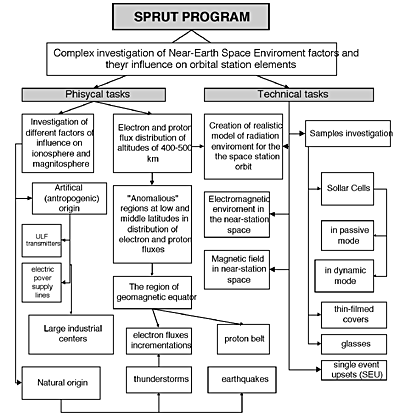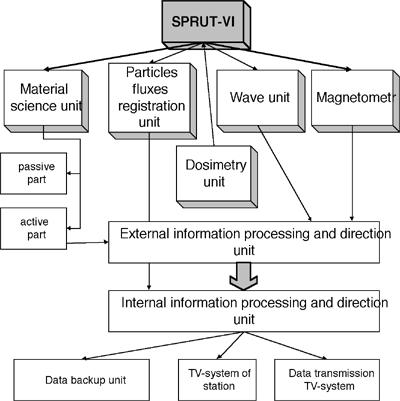This article is very kindly provided to
LoScrittoio.it from Dr Stanislav Klimov (Head of the ElectroMagnetic
Laboratory at the Space Research Institute -I.K.I.- of Russia).
We wish thanks Dr Klimov and his collegues to have choosen LoScrittoio.it
to publish their impor-tant work actually under way on the MIR
Space Station, back to life recently.
LoScrittoio.it is proud to present this article to its readers.
Flavio Gori
COMPLEX SPACE EXPERIMENT "SPRUT"
O.Grigoryan1, S.Klimov2, V.Nikitsky3, V.Korepanov4, S.Ryabukha3, I.Tchurilo3,
1 Skobeltsyn Institute of
Nuclear Physics Moscow State University, 119899, Mos-cow, Russia,
2 Space Research Institute, 117810, Moscow, Russia,
3 Rocket-Space Complex "Energia", 141070, Korolev,
Moscow region, Russia
4 L`vov Centre Space Research Institute, 290601, L`vov-53,
Ukraine
ABSTRACT
Description of SPRUT program which main task is providing of complex measur-ing the largest possible number of NSE parameters and simultaneously their in-fluence on elements of the piloted orbital stations.
INTRODUCTION
In connection with: the development
of thin-film covers technology; the neces-sity to increase solar
cells operation time; increasingly active use of microe-lectronics
elements with a high degree of integration, as well as accumulation
of a vast amount of data on the various factors of the Near-Earth-space-environment
(ESE), the urgent ne
experiment and requiring explanation are given:
discrepancies between the standard model distribution of electron
and proton fluxes (ÀÅ-8 and À_-8, low-altitude
boundary of applicability of models L > 1.2 and L > 1.15
accordingly) and recent numerous satellite experimental data;
existence of a proton (with energies up to several MeV) "belt"
on L < 1.15 (Biryukov, 1996);
sporadic occurrence of electron fluxes with energy of tens -
hundreds keV on L < 1.2 (Grigoryan, 1997a);
existence in certain longitude intervals of electron fluxes with
energy up to ~ 1MeV at low and average latitudes (L ~ 1.2-1.8);
observation near the geomagnetic equator of a region of low-frequency
elec-tromagnetic waves (up to hundreds kHz) and direct current
electric fields Edc (amplitude up to 50-100 mV/m) (Grigoryan,
1997a).
DISCUSSION AND CONCLUSIONS
The program of complex space
experiment SPRUT has currently been prepared and its basic goals
are:
studies of charged particle fluxes (electrons and protons with
energies Ee,p>50keV) and specification of radiation conditions
in a space stations trajec-tory; development of real space-time
and energetic distribution of electron and proton flux models
(at altitudes of 300-500 km), taking into account the contri-bution
of "abnormal" areas of energetic (up to 1,5-2,0 MeV)
electron fluxes dis-tribution at average and low longitudes and
proton fluxes with energy Å_<1-5 MeV near to geomagnetic
equator; studies of distribution of electromagnetic radiation
in a wide frequency range (0.01Hz - 10.0 MHz) and definition
of areas of the increased concentration of ra-diation;
simultaneous study of electrical and magnetic anomalies and fluxes
of elec-trons with energy Ee > 50 keV;
study of physical-chemical mechanisms of complex influence of
the damaging NSE factors and conditions of orbital flight on
solar cell nonmetal materials, thin-film coverings, onboard equipment
both elements of the space station de-sign and estimation of
probability of single failures and refusals of typical mi-croelectronics
elements with a high degree of integration.
Fig. 1
The program has several stages of realization. The first is intended
for im-provement of the complex as a whole and techniques of
the control of service-ability of photo-electric converters in
conditions of real space flight. The pro-gram of the first stage
is given in Fig.1.
In Fig.2 the structure of the device SPRUT-VI intended for solving
the above for-mulated tasks is shown schematically (Grigoryan,
1997b).

Fig. 2
In the methodical plan the device SPRUT-VI is a combination of
independent com-plexes of scientific equipment with common ideology,
control systems, accumu-lation and transmission of the data.
The device consists of:
material investigation complex, incorporating passive and active
parts; the first is intended for accommodation of solar cells,
coverings, thin-filmed cov-erings, glasses, dosimeter, second
- for work with elements of solar cells in a dynamic mode, in
particular, for obtaining the volt-ampere characteristics of
solar cells and measurements of potential, induced in shielding
covering; the special program on study of single failures in
microelectronics elements is foreseen also;
complex for study of power and space-time distribution of energetic
charged particles fluxes;
wave complex, on the initial stage of expansion of the device
intended for research of intensity of local spectra in a low-frequency
part of a wave spectrum, using method of complex wave diagnostics;
magnetometer;
dosimeter complex, the components of which are placed both inside
station, and on its surface.
At the subsequent stages of development of the device the installation
of a high-frequency wave complex, complex for research of the
characteristics of cold plasma, registration of electromagnetic
radiation in ultra-violet area is pro-vided.
For "unloading" the central processor unit each complex,
which is included in structure of the device SPRUT-VI, has its
own controller, the information from detectors located outside
of station (except for detectors of particles), goes to the external
block of information processing and management (system has a
back-up in case of failure), and then goes to block 360 (module
of the central processor), which besides processing and accumulation
of the scientific and service (technical) information maintain
communication with onboard systems of station. Three systems
of information transfer are stipulated in the device:
independent storage on hard disk drives with the subsequent transmitting
to the Earth;
use of standard TeleMetrical-system of station;
use of special TV-system capable to transfer on the Earth up
to 20 Mbytes/day.
For data and instructions (commands) exchange between the block
of electronics and scientific and technical complexes of the
device there are intellectual e lectronics,
which uses consecutive multiplexor bus interfaces in the standard
RS 485 and CUNBUS.
lectronics,
which uses consecutive multiplexor bus interfaces in the standard
RS 485 and CUNBUS.
The device SPRUT-VI allows to
measure:
fluxes of electrons and protons in a range of energies from 50
keV up to > 2.5 MeV and up to > 30 MeV respectively;
fluxes of a-particles and CNO group nucleuses with energies >
4 and > 5 MeV/nucleon;
wave radiation in a range of frequencies from 0.01 Hz up to 20.0
kHz;
three components of a constant magnetic field (60000);
magnetic fluctuations on the station surface in a range of frequencies
from 0.1 Hz up to 40 kHz;
three components of direct current electrical field Edc (
-20 V);
currents on the surface of station from till À/ñì2;
potential of station surface elements from up to 20 V;
radiation dose received by exhibited elements as behind shielding
(inside sta-tion), and on its surface.
Below, we point out the basic
features of the SPRUT-VI instrument:
measurement by one device of the basic parameters describing
the condition of station environmental space, with simultaneous
recording of station design elements reaction on basic parameters
influence;
the work of all complexes is united by the uniform electronics
block, allowing to carry out complex processing of the incoming
information, its storage and transfer to appropriate systems,
and also carrying out under the coordinated program management
of all parts of the device;
the measurements of particle fluxes and wave measurements are
carried out simultaneously (parallel) in wide energy and frequency
ranges with high time resolution;
the device allows to carry out direct measurements of currents
in ionospheric plasma;
the unified hardware construction of measuring-amplifying channels
of signals formation for the spectral-temporary analysis of measured
parameters is used in the device.
Thus for piloted orbital complex the SPRUT program has currently been developed. It provides simultaneous complex studies of various construction materials under real space flight conditions. For the accomplishment of this program specialized equipment - the SPRUT instrument has been produced, which permits to solve the above listed problems.
REFERENCES
Biryukov A., O.Grigoryan, S.Kuznetsov,
A.Ryaboshapka, S.Ryabucha, Low-energy charged particles at near
equatorial latitudes according to "MIR" orbital station
data, Adv. Space Res., 17, (10) 189 (1996).
Grigoryan O., A.Sinyakov, S. Klimov, Energetic electrons on l
< 1.2: connection to lightning activity, Adv. Space Res.,
20, 389 (1997a).
Grigoryan O, S.Klimov, Z.Klos et al., Ecological monitoring
device onboard MIR sta-tion, Engineering ecology, 2, 44
(1997b).